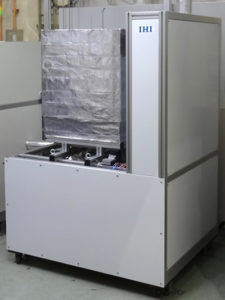Direct Ammonia Fuel Cells Take Another Step Forward in Japan
By Stephen H. Crolius on May 31, 2018
Japanese manufacturing concern IHI reported on May 16 that it had “successfully generated 1 kW class power” from a direct ammonia solid oxide fuel cell. This is the latest milestone for a technology that could play a major role in the roll-out of Japan’s Hydrogen Society.
The development of the direct ammonia SOFC technology has been well documented in NH3 Fuel Conference presentations, technical papers, and Ammonia Energy posts. At the story’s start, Hiroki Murayama, Assistant Professor of Energy and Hydrocarbon Chemistry at Kyoto University, delivered a paper at the 2014 NH3 Fuel Conference entitled “Research and development of NH3-fueled solid-state fuel cell systems.” Co-authored by Koichi Eguchi, now leader of the Eguchi Laboratory at Kyoto University, the paper’s abstract started with a statement of ammonia’s virtues as a “carbon-free fuel source for fuel cell systems.” Key on this list is the fact that “hydrogen and nitrogen originating from ammonia fuel are expected to have little negative effect on fuel cell performance, while hydrocarbon fuels draw some severe problems at electrodes, such as CO poisoning or carbon deposition in low- and high-temperature fuel cells, respectively.” The implied context for the conceptualization that ensued was stationary environments. A wide range of technical approaches was considered, including anion-exchange membrane fuel cells and SOFCs, as well as various approaches to ammonia pretreatment and catalyst systems.
Over the course of the next year, the effort acquired Toyota Industries, ceramics manufacturer Noritake, and chemical companies Tokuyama, Nippon Shokubai, and Mitsui Chemicals as industry partners. The work has received support from the Cross-Ministerial Strategic Innovation Promotion Program (SIP) since at least 2016.
In late 2015, Eguchi and his team published a review of catalytic anode materials for SOFCs in the Journal of Power Sources. By the time of the NH3 Fuel Conference in September 2016, Eguchi was able to report “development of ammonia-fueled SOFC systems [including] 200 W-class stacks as well as button-type cells.” In a July 2017 Japan Science and Technology Promotion Organization (JST) press release, Eguchi reported that the team had graduated to a 1 kW unit that could be compared with a “household unit supplied with city gas.”
The JST announcement included the first mention of IHI as an industry partner, although the company has had a fuel cell technology program of its own since at least the early 2000s. In August 2017, Nikkei Sangyo ran a story (“JGC and IHI utilize ammonia for hydrogen power generation”) reporting that IHI had “started to commercialize fuel cells using ammonia.” The story also mentioned that IHI intends “to prototype a 1 kilowatt class equipment with power generation output, and will conduct a verification test in fiscal 2018.” IHI’s May 16 announcement fulfills this pledge, presumably with a version of the Kyoto University technology that is adapted for industrial production.
A February 8, 2018 Ammonia Energy post speculated that IHI’s target for its SOFC product would be the residential market. Called “Ene-Farms” and fueled with natural gas, residential fuel cells have been sold in Japan since the late 2000s. With 2015 sales of approximately 40,000 units, Ene-Farms remain the most visible manifestation of the emerging Hydrogen Society. A May 18, 2017 Ammonia Energy post reported that “the devices, packaged in enclosures about the size of a refrigerator, convert natural gas into electricity and heat that can be used for hot water and space warming.” They typically have an electrical generation capacity of 700 watts.
The Ammonia Energy speculation notwithstanding, IHI’s May 16 announcement states that the company’s plan is to “continue to enlarge the system for business and industrial applications in the future.” This may be a hint about how IHI will address the alternative-fuel chicken-and-egg problem (how to build customer interest in a device that runs on a fuel that is not widely available; how to invest in delivery infrastructure for a fuel for which there is no demand). In the transportation sector, this problem is being addressed in part by focusing on large commercial and industrial customers who can use the size of their captive fleets to justify the installation of dedicated fueling assets. In the analogous play for IHI, SOFCs could be installed initially in tandem with on-site ammonia storage facilities and over-the-road delivery arrangements.
The natural-gas-fueled Ene-Farms can achieve 95% total energy efficiency based on chemical-to-electricity conversion efficiency in the 40-50% range and productive use of byproduct heat. Even with the savings on energy costs that this implies, the up-front prices of the units (¥1.5 million ($13,300) in 2017) are at a level that constrains their commercial viability absent government subsidies (currently in the 20-30% range).
It appears the same considerations will apply to IHI’s ammonia-fueled units. The Nikkei Sangyo article reported that “The power generation efficiency [of the IHI product] aims at the latter half of the 40% level which is comparable to that of residential fuel cells already in practical use.” So far, though, there does not seem to have been any public mention of how or whether the Ene-Farm subsidy regime will be applied to ammonia-fueled units.
The market potential for non-residential Ene-Farms is vast. According to figures from Tokyo Gas, industrial and commercial customers account for 60% of Japan’s natural gas consumption. Tokyo Gas supplies more than 600,000 such customers in its service territory alone. The central government has so far prioritized the residential market, having established targets of 1.4 million units installed by 2020 and 5.3 million units by 2030. (Tokyo Gas states that 27 million of Japan’s 50 million households are natural gas customers.) However, it is not clear how the transition from natural gas to a sustainable hydrogen-based fuel will be effected for any type of establishment currently served by the country’s gas pipeline system. The answer may depend on how IHI fares with its direct ammonia SOFCs in the non-residential market.
IHI is a member of Japan’s Green Ammonia Consortium.
